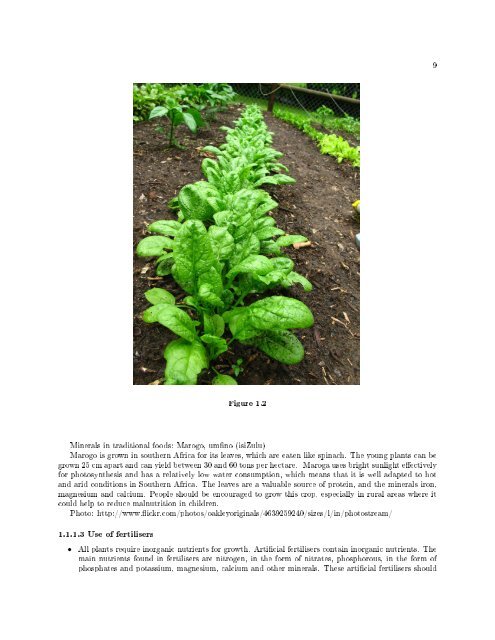- Page 1: Siyavula: Life Sciences Grade 10Col
- Page 4 and 5: This selection and arrangement of c
- Page 7 and 8: Subject Orientation 1What is Life S
- Page 9: school, high school or university.
- Page 12 and 13: 6 CHAPTER 1. LIFE AT THE MOLECULAR,
- Page 16 and 17: 10 CHAPTER 1. LIFE AT THE MOLECULAR
- Page 18: 12 CHAPTER 1. LIFE AT THE MOLECULAR
- Page 21 and 22: 151.1.3.3.4 Biological importance
- Page 23 and 24: 17Figure 1.81.2.6.3Functioning of e
- Page 25 and 26: 19Figure 1.10Figure. X. Aloe vera h
- Page 27 and 28: • Inorganic compounds can contain
- Page 29 and 30: 23Figure 1.13By grinding his own le
- Page 31 and 32: 25Figure 1.14Need annotated image w
- Page 33 and 34: 27Figure 1.16Transmission electron
- Page 35 and 36: 29Figure 1.181. Nucleolus 262. Nucl
- Page 37 and 38: 1.2.1.1.6 MitochondriaA mitochondri
- Page 39 and 40: 1.2.1.1.10 Structures unique to ani
- Page 41 and 42: 35cell from bursting when water ent
- Page 43 and 44: transport vesicleA vesicle that is
- Page 45 and 46: State Phase Abbreviation Descriptio
- Page 47 and 48: 411.3.1.3 Stages of MitosisFigure 1
- Page 49 and 50: 43• The discovery of the organell
- Page 51 and 52: 45You are required to produce a TYP
- Page 53 and 54: 47• two heat-resistant test tubes
- Page 55 and 56: 49Observation• observe the reacti
- Page 57 and 58: Chapter 2Life processes in plants a
- Page 59 and 60: 2.1.2 Dicot root2.1.2.1 External st
- Page 61 and 62: 55Figure 2.2Diagram of xylem• Thr
- Page 63 and 64: LightPlants transpire more rapidly
- Page 65 and 66:
592.2.1.3 Variation:Be creative and
- Page 67 and 68:
1. Fill one jar with plain water, a
- Page 69 and 70:
2.5 Unit 2.2 Investigation 1 - Tree
- Page 71 and 72:
652.6.1.1.4EndoskeletonThis skeleto
- Page 73 and 74:
Available:http://www.clisnotes.com/
- Page 75 and 76:
69• provide internal core structu
- Page 77 and 78:
712.7.3.3.3 Cardiac muscle• Respo
- Page 79 and 80:
3. Strengthen your skeleton by drin
- Page 81 and 82:
___________________________________
- Page 83 and 84:
77i. Do you smoke?ii. Are you overw
- Page 85 and 86:
2.10.5Systemic circulation (to all
- Page 87 and 88:
(from above) vena cava, and can the
- Page 89 and 90:
Figure 10. Circulatory systems of s
- Page 91 and 92:
85Figure 2.14Table 2.5The HeartThe
- Page 93 and 94:
Figure 11. The relationship of the
- Page 95 and 96:
89Figure 2.17from mindsetOne comple
- Page 97 and 98:
91Figure 2.18Table 2.7.Human heartb
- Page 99 and 100:
93Figure 2.21Table 2.8Heartbeats ar
- Page 101 and 102:
95Figure 2.23Table 2.10The heart co
- Page 103 and 104:
2.10.15 Middle layer smooth muscle
- Page 105 and 106:
Chapter 3Environmental studies3.1 B
- Page 107 and 108:
The troposphere is the atmospheric
- Page 109 and 110:
3.2 Environment 63.2.1 Environment3
- Page 111 and 112:
105Figure 3.1Light reects o of the
- Page 113 and 114:
To discover how to reduce your carb
- Page 115 and 116:
1093.2.1.7.3 The Story of StuTo see
- Page 117 and 118:
Chapter 4Diversity, change and cont
- Page 119 and 120:
INDEX 113Index of Keywords and Term
- Page 121 and 122:
ATTRIBUTIONS 115AttributionsCollect
- Page 123 and 124:
ATTRIBUTIONS 117Module: "UNIT 2.3 T




![Mum, int. [man] - Cd3wd.com](https://img.yumpu.com/51564724/1/190x134/mum-int-man-cd3wdcom.jpg?quality=85)











